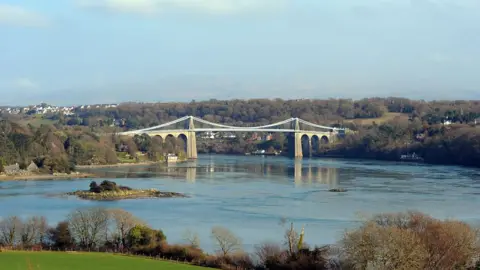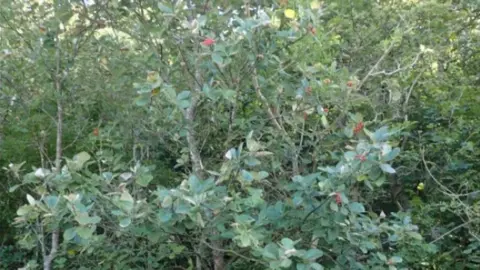Menai whitebeam: Bangor University to protect endangered tree
 Getty Images
Getty ImagesUniversity researchers are leading efforts to save one of the world's most threatened species of tree, after finding it growing a few miles away.
There are only about 30 Menai whitebeam left - and they are all on a small stretch of coast between the Welsh mainland and Anglesey.
The tree is listed as being on the brink of extinction in the landmark State of the World's Trees report.
Experts from nearby Bangor University are now hoping to save it.
"I was amazed to realise that such a highly-threatened tree could be found in a nature reserve not far from our university," said professor of conservation science Julia Jones.
"The Menai whitebeam raises interesting questions about what defines a species and has the potential to engage local people in local conservation. We are just starting to do some research on the tree and the threats it faces."
Her student Hannah Taylor has decided to do a dissertation on it, and she said it was great to know her work could help protect "a critically endangered tree".
 Robbie Blackhall-Miles
Robbie Blackhall-MilesState of the World's Trees was published by Botanic Gardens Conservation International and is one of the first assessments of the world's threatened trees.
It revealed that 30% (17,500) of the world's 60,000 tree species are currently at risk of extinction.
That means there are twice as many threatened tree species as threatened mammals, birds, amphibians and reptiles combined.
Of these, 440 species are right on the brink of extinction - meaning they have fewer than 50 remaining in the wild.
With only 30 Menai whitebeam (Sorbus arvonensis) along the coast of the Menai Strait, it is in this bracket.
 Bangor University
Bangor UniversityHowever, the report gives hope by saying that identifying those at threat, and ensuring they are protected, is the most effective way to prevent extinction.
In addition, more than 64% of those at risk grow in at least one protected area and about 30% are nurtured in places such as botanic gardens and seed banks.
But further action is needed, the report said.
The remaining Menai whitebeam are at the Nantporth Nature Reserve, making the area "unique", according to senior reserve manager Chris Wynne.
It is managed by the North Wales Wildlife Trust, and he said: "It adds another dimension to this wonderful, atmospheric woodland, dripping with ferns, dotted with colourful flowers in spring and the sound of birdsong.
"And all this a short distance from Bangor town centre on the Wales Coastal Path."
Robbie Blackhall-Miles helps save endangered species and has recently been involved in attempts to revive the Snowdonia Hawkweed - of which only three plants have been confirmed in the wild.
He is based in Gwynedd and has now joined the efforts to save the Menai whitebeam as well.
"I work to conserve endangered plant species from all over the world so when I found out that something so threatened was growing right here on my doorstep, I had to do something to make sure we didn't lose it forever," he said.
What is the Menai whitebeam?
It is a member of one of the of the most diverse tree groups in Europe - the Sorbus trees, also known as rowan or whitebeams.
Of the 170 species of Sorbus native to Europe, more than 75% are considered threatened.
Many species of Sorbus have a small population size, predisposing them to threatening events.
They are often light-demanding and palatable to herbivores, so are found in restricted habitats such as ungrazed rocky cliffs.
The Menai whitebeam grows in just one small section of steep coast along the Menai Straits.

- CAN MUSHROOMS SAVE THE WORLD?: What makes mushrooms so magical?
- THE LONG WALK HOME: 20,000 miles, 4 years, 1 man

